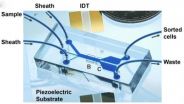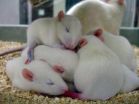(Press-News.org) COLUMBIA, Mo. – Boron deficiency is one of the most widespread causes of reduced crop yield. Missouri and the eastern half of the United States are plagued by boron deficient soil and, often, corn and soybean farmers are required to supplement their soil with boron; however, little is known about the ways in which corn plants utilize the essential nutrient. Now, researchers at the University of Missouri have found that boron plays an integral role in development and reproduction in corn plants. Scientists anticipate that understanding how corn uses the nutrient can help farmers make informed decisions in boron deficient areas and improve crop yields.
"Boron deficiency was already known to cause plants to stop growing, but our study showed that a lack of boron actually causes a problem in the meristems, or the stem cells of the plant," said Paula McSteen, associate professor in the Division of Biological Sciences and a researcher in the Bond Life Sciences Center at MU. "That was completely unknown before. Through a series of experiments involving scientists from several disciplines at MU, we were able to piece together the puzzle and reach a new conclusion."
Meristems comprise the growing points for each plant, and every organ in the plant is developed from these specialized stem cells. Insufficient boron causes these growing points to disintegrate, affecting corn tassels and kernels adversely. When tassels are stunted, crop yields are reduced, McSteen said.
The research evaluated a group of plants stunted by its ability to grow tassels. Kim Phillips, a graduate student in McSteen's lab, mapped the corn plant's genome and found that a genetic mutation stunted tassel growth because it was unable to transport boron across the plant membranes, inhibiting further growth in the plants.
Amanda Durbak, a post-doctoral fellow in the College of Arts and Science at MU, also helped prove boron's usefulness to meristems. She treated two groups of tassel-less corn, one with a boron fertilizer and the other with only water. The group that was treated with boron grew normally, while the group treated with water withered.
Further testing revealed that, at the cellular level, the affected plants' meristems had altered pectin which is strengthened with boron and stabilizes the plant cell. Without the pectin, plant meristems disintegrate.
"By using various techniques and expertise at MU, including genomics, translational experiments with frog eggs, research in the field, cellular testing, and evaluations at the MU Research Reactor Analytical Chemistry facility and at MU Plant and Soil Analysis Facility, the study team drew conclusions that will help corn producers make informed decisions about raising crops in boron deficient zones," McSteen said.
INFORMATION:
Researchers at the University of Georgia and at California State University, Long Beach also contributed to this study. The paper, "Transport of boron by the tassel-less 1 aquaporin is critical for vegetative and reproductive development in maize," was published in The Plant Cell and was funded in part by the National Science Foundation.
Editor's Note: For a longer version of this story, please visit: http://decodingscience.missouri.edu/2014/08/boron-vital-for-plant-stem-cells/
For related video, please visit: https://www.youtube.com/watch?v=8gpYwS4wO8Y
Researchers find boron facilitates stem cell growth and development in corn
Results could lead to advancements in corn crop yields and farming techniques
2014-08-25
ELSE PRESS RELEASES FROM THIS DATE:
High insulin levels tied to obesity pathway, new UT Southwestern research shows
2014-08-25
UT Southwestern Medical Center researchers have identified a crucial link between high levels of insulin and pathways that lead to obesity, a finding that may have important implications when treating diabetes.
Researchers with the UT Southwestern's Touchstone Center for Diabetes found that giving mice high levels of insulin, which is typically done to counter the effects of diabetes or insulin resistance in Type 2 diabetes, also fosters processes that lead to obesity.
The discovery was made by studying mice engineered to lack receptors for a hormone called glucagon.
Glucagon ...
Finding keys to glioblastoma therapeutic resistance
2014-08-25
Researchers at the University of California, San Diego School of Medicine have found one of the keys to why certain glioblastomas – the primary form of a deadly brain cancer – are resistant to drug therapy. The answer lies not in the DNA sequence of the tumor, but in its epigenetic signature. These findings have been published online as a priority report in the journal Oncotarget.
"There is a growing interest to guide cancer therapy by sequencing the DNA of the cancer cell," said Clark Chen, MD, PhD, vice-chairman of Research and Academic Development, UC San Diego Division ...
Gut bacteria that protect against food allergies identified
2014-08-25
The presence of Clostridia, a common class of gut bacteria, protects against food allergies, a new study in mice finds. By inducing immune responses that prevent food allergens from entering the bloodstream, Clostridia minimize allergen exposure and prevent sensitization – a key step in the development of food allergies. The discovery points toward probiotic therapies for this so-far untreatable condition, report scientists from the University of Chicago, Aug 25 in the Proceedings of the National Academy of Sciences.
Although the causes of food allergy – a sometimes deadly ...
Key to universal flu vaccine: Embrace the unfamiliar
2014-08-25
Vaccine researchers have developed a strategy aimed at generating broadly cross-reactive antibodies against the influenza virus: embrace the unfamiliar.
In recent years, researchers interested in a "universal flu vaccine" identified a region of the viral hemagglutinin protein called the stem or stalk, which doesn't mutate and change as much as other regions and could be the basis for a vaccine that is protective against a variety of flu strains.
In an Emory Vaccine Center study, human volunteers immunized against the avian flu virus H5N1 readily developed antibodies ...
SA's Taung Child's skull and brain not human-like in expansion
2014-08-25
The Taung Child, South Africa's premier hominin discovered 90 years ago by Wits University Professor Raymond Dart, never seizes to transform and evolve the search for our collective origins.
By subjecting the skull of the first australopith discovered to the latest technologies in the Wits University Microfocus X-ray Computed Tomography (CT) facility, researchers are now casting doubt on theories that Australopithecus africanus shows the same cranial adaptations found in modern human infants and toddlers – in effect disproving current support for the idea that this early ...
A long childhood feeds the hungry human brain
2014-08-25
EVANSTON, Ill. -- A five-year old's brain is an energy monster. It uses twice as much glucose (the energy that fuels the brain) as that of a full-grown adult, a new study led by Northwestern University anthropologists has found.
The study helps to solve the long-standing mystery of why human children grow so slowly compared with our closest animal relatives.
It shows that energy funneled to the brain dominates the human body's metabolism early in life and is likely the reason why humans grow at a pace more typical of a reptile than a mammal during childhood.
Results ...
Black carbon -- a major climate pollutant -- also linked to cardiovascular health
2014-08-25
Black carbon pollutants from wood smoke are known to trap heat near the earth's surface and warm the climate. A new study led by McGill Professor Jill Baumgartner suggests that black carbon may also increase women's risk of cardiovascular disease.
To investigate the effects of black carbon pollutants on the health of women cooking with traditional wood stoves, Baumgartner, a researcher at McGill's Institute for the Health and Social Policy, measured the daily exposure to different types of air pollutants, including black carbon, in 280 women in China's rural Yunnan province.
Baumgartner ...
Tilted acoustic tweezers separate cells gently
2014-08-25
Precise, gentle and efficient cell separation from a device the size of a cell phone may be possible thanks to tilt-angle standing surface acoustic waves, according to a team of engineers.
"For biological testing we often need to do cell separation before analysis," said Tony Jun Huang, professor of engineering science and mechanics. "But if the separation process affects the integrity of the cells, damages them in any way, the diagnosis often won't work well."
Tilted-angle standing surface acoustic waves can separate cells using very small amounts of energy. Unlike ...
New biomarker highly promising for predicting breast cancer outcomes
2014-08-25
A protein named p66ShcA shows promise as a biomarker to identify breast cancers with poor prognoses, according to research published ahead of print in the journal Molecular and Cellular Biology.
Cancer is deadly in large part due to its ability to metastasize, to travel from one organ or tissue type to another and malignantly sprout anew. The vast majority of cancer deaths are associated with metastasis.
In breast cancer, a process called "epithelial to mesenchymal transition" aids metastasis. Epithelial cells line surfaces which come into contact with the environment, ...
Exposure to toxins makes great granddaughters more susceptible to stress
2014-08-25
Scientists have known that toxic effects of substances known as endocrine disrupting chemicals (EDCs), found in both natural and human-made materials, can pass from one generation to the next, but new research shows that females with ancestral exposure to EDC may show especially adverse reactions to stress.
According to a new study by researchers from The University of Texas at Austin and Washington State University, male and female rats are affected differently by ancestral exposure to a common fungicide, vinclozolin. Female rats whose great grandparents were exposed ...
LAST 30 PRESS RELEASES:
Membrane magic: FAMU-FSU researchers repurpose fuel cells membranes for new applications
UN Member States pledge to increase access to diagnosis and inhaled medicines for the 480 million people living with COPD
Combination therapy shows potential to treat pediatric brain cancer ATRT
Study links seabird nesting to shark turf wars in Hawai‘i
Legal sports betting linked to sharp increases in violent crime, study finds
Breakthrough AI from NYUAD speeds up discovery of life-supporting microbes
New Eva Mayr-Stihl Foundation funding initiative boosts research at University of Freiburg on adaptation of forests to global change
The perfect plastic? Plant-based, fully saltwater degradable, zero microplastics
Bias in data may be blocking AI’s potential to combat antibiotic resistance
Article-level metrics would provide more recognition to most researchers than journal-level metrics
Satiety’s little helper: Protein that supports appetite regulating protein identified
UF dives deep into predicting storm damage with computer models
A stormy ocean voyage yields insights on the global carbon cycle
Scientists identify first non-coding gene that controls cell size
Demonstration of altermagnetism in RuO₂ thin films -- A new magnetic material for the AI era
Penn researchers awarded $25M to conduct trial using smartphones to fight heart disease
PCORI awards funding for new patient-centered healthcare research
Exploring the origins of the universe: 145 low-noise amplifiers complete ALMA telescopes
Empress cicada wings help illuminate molecular structure
Using sound waves to detect helium
Time burden in patients with metastatic breast and ovarian cancer from clinic and home demands
Researchers discover bias in AI models that analyze pathology samples
Scientists ID potential way to prevent brain injuries from triggering Alzheimer's
MASTER 2nd Open Call: Execution period kick-off
Algae for health in food and pharma
Advanced microrobots driven by acoustic and magnetic fields for biomedical applications
Chicago health information leader recognized for raising CPR readiness and blood pressure awareness
The Intimate Animal, a new book from Kinsey Institute Executive Director Dr. Justin Garcia
When blue-collar workers lose union protection, they try self-employment
New video dataset to advance AI for health care
[Press-News.org] Researchers find boron facilitates stem cell growth and development in cornResults could lead to advancements in corn crop yields and farming techniques




